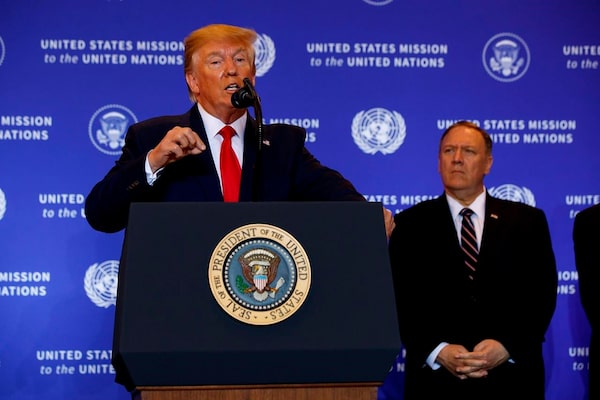
U.S. President Donald Trump speaks during a news conference during the United Nations General Assembly, Sept. 25, 2019, in New York.The Associated Press
On Wednesday, the White House released an edited, five-page rough transcript of U.S. President Donald Trump’s phone call in July with Ukrainian President Volodymyr Zelensky. Here are six key takeaways from the nearly 2,000-word text, which has sparked an impeachment inquiry by Congressional Democrats.
1) The Footnote
In a footnote, the White House warned that it was not a complete verbatim retelling of the 30-minute call. Instead, the document is a reconstruction of the conversation put together by National Security Council staff and White House officials who listened inside in the Situation Room, a secure meeting space in the basement of the White House. Several portions of the document are redacted and replaced with ellipses. It is also not clear from the text whether the two leaders spoke in English, although U.S. media reports suggest they spoke through a translator. The changes have led to complaints by Mr. Trump’s political opponents that the official release may be missing important elements.
2) CrowdStrike
Mr. Trump asks Mr. Zelensky to investigate Ukraine’s role in the hacking of Democratic National Committee e-mails during the 2016 U.S. presidential election. In doing so, Mr. Trump reiterates a conspiracy theory popular among many of his supporters that Ukraine, not Russia, was behind the attack.
The DNC hired cybersecurity firm CrowdStrike to investigate the 2016 e-mail hack. CrowdStrike’s investigation linked the attack to groups with close ties to Russian intelligence services, a finding backed by former U.S. special counsel Robert Mueller.
But Mr. Trump has repeatedly taken issue with Democratic officials calling in an outside company to investigate and giving FBI investigators only copies of e-mail servers, leading to unsubstantiated claims that a missing e-mail server has found its way to Ukraine. CrowdStrike has said that all relevant information was turned over to the FBI. The firm, which went public this summer, is based in Silicon Valley.
3) The prosecutor: Mr. Trump asks Zelensky to investigate political rival Joe Biden
Mr. Trump shifts the conversation toward Joe Biden, the front-runner in the Democratic presidential race. He asks Mr. Zelensky to investigate whether Mr. Biden politically meddled in Ukraine to block an investigation into a company with ties to Mr. Biden’s son, Hunter. This part of the conversation forms the crux of the Democrats’ impeachment inquiry into the U.S. President’s conduct.
As vice-president in the Obama administration, Mr. Biden criticized Ukraine’s top prosecutor, Viktor Shokin, who was widely seen as weak on corruption. In 2016, Mr. Biden travelled to Kiev to press officials to fire Mr. Shokin in exchange for a US$1-billion loan from the United States, according to a speech Mr. Biden gave to the Council on Foreign Relations last year.
Mr. Trump and his supporters have alleged that Mr. Biden was motivated by trying to protect his son, who was a director of Burisma Holdings, a Ukrainian gas company that was under investigation by Mr. Shokin’s office. Mr. Biden has denied the claim and Hunter Biden stepped down from Burisma this year.
4) The ambassadors
Mr. Trump harshly criticizes his country’s own former ambassador to Ukraine, Marie Yovanovitch, whom he recalled from the post in May, two months before she was set to step down.
Ms. Yovanovitch, a long-time diplomat appointed by the Obama administration, was an outspoken critic of the slow pace of Ukrainian corruption investigations. In March, Ukraine’s top prosecutor general Yuriy Lutsenko accused Ms. Yovanovitch of providing a list of people who should not be prosecuted in Ukraine, though he has since walked back his remarks.
5) Trump said he would enlist Attorney-General William Barr
Mr. Trump repeatedly asks the Ukrainian President to speak with both Attorney-General William Barr and Mr. Trump’s lawyer, former New York mayor Rudy Giuliani, about Mr. Biden.
The call raised alarms among Democrats that Mr. Barr, the country’s top justice official, was co-ordinating with the President’s personal lawyer to pressure a foreign government to investigate Mr. Trump’s domestic political rivals.
The Justice Department issued a statement denying that Mr. Barr had ever received a request from the President to speak with Ukrainian officials. Democratic Congressional leaders, however, used the rough transcript to question the Justice Department’s motivations in refusing to turn over a whistle-blower’s complaint into Mr. Trump’s discussions with Mr. Zelensky. The Office of the Director of National Intelligence agreed to provide the complaint to U.S. lawmakers on Wednesday.
6) Quid Pro Quo - They talk about Ukraine buying US oil; javelins
Key to the Democrats’ impeachment inquiry into Mr. Trump will be whether there is any evidence that the U.S. President put pressure on Mr. Zelensky to investigate Mr. Biden in return for U.S. aid and whether there was a tacit agreement between the two leaders.
At the time of the call, the Trump administration had frozen military aid allocated by U.S. Congress to Ukraine to protect against Russian aggression. Neither Mr. Trump nor Mr. Zelensky mentions explicit U.S. support in return for an investigation. But Mr. Trump repeats that the United States has been “very, very good for Ukraine” while suggesting the support hasn’t always been reciprocal.
Mr. Zelensky agrees that U.S. support has been critical. He mentions wanting closer co-operation with the United States, referencing his country’s desire to have energy independence from Russia. He reminds Mr. Trump that Ukraine is “buying American oil.” Earlier in the conversation, he suggests Ukraine could purchase more Javelins – a U.S.-made guided missile system.